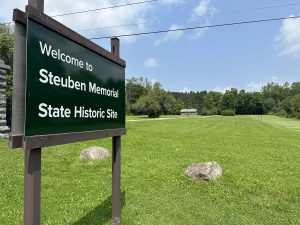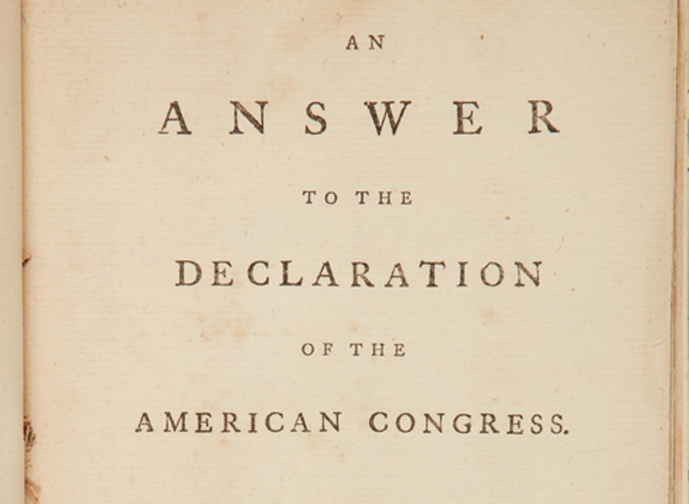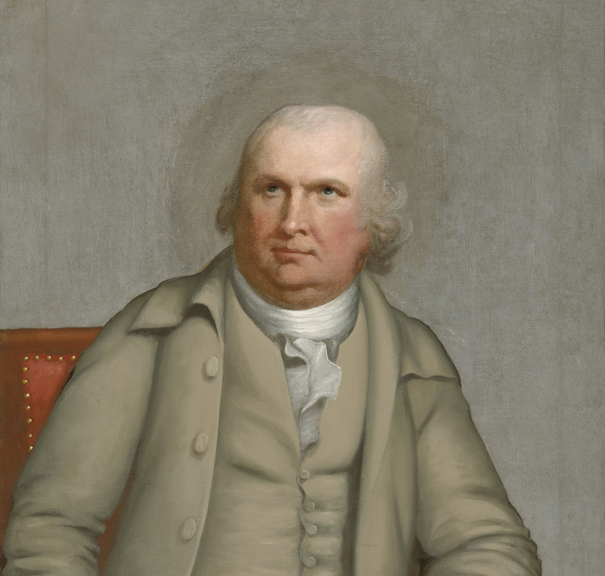Friedrich Wilhelm von Steuben, more commonly known as Baron von Steuben, served as a military officer in both the Prussian and American armies. He fought in the Prussian army for sixteen years, rising through the ranks from cadet in 1747 to adjutant general on the king’s staff in 1759. In 1762, he served as aide-de-camp to King Frederick II.[1] With the end of the Seven Years’ War, Steuben resigned his commission and spent his time at court and traveling.
In September 1777, Benjamin Franklin and Silas Deane recommended von Steuben’s services to George Washington. They detailed his lengthy service with the Prussian king and had the recommendation of the French foreign minister, Comte de Vergennes and minister of war Comte de St. Germain. Franklin and Deane described von Steuben as having “a true Zeal for our Cause, and a View of engaging in it, and rendering it all the Service in his Power.”[2] In his own letter to Washington, von Steuben offered to serve as a volunteer, and stated, “the Object of my greatest Ambition is to render your Country all the Services in my Power.”[3]
General Washington recognized the value of Baron von Steuben’s military experience and appointed him inspector general of the Continental Army. Von Steuben utilized the Commander in Chief’s Guard to build a model company of soldiers,[4] used to train the rest of the army. The Baron’s drill manual, called the Blue Book because early editions were printed with blue covers, provided the foundation of training that has evolved and endured in the U.S. Army. The book given to new recruits upon entering basic training is still called The Soldier’s Blue Book.[5]

Despite his legacy and fame as a Founding Father, Baron von Steuben’s life after the Revolutionary War is less familiar. He received property from various states as thanks for his patriotic service, though like much of the Continental Army, he never received all the pay he was due. New Jersey granted him the use of a house which had formerly belonged to Jan Zabriskie, a Loyalist. Five years later, von Steuben sold the house and lands back to the Zabriskie family to pay debts.[6] He wrote to William North, a former aide-de-camp, that as soon as the house was sold, the proceeds would “immediately pay to you the money, you so generously lend me.”[7] After leaving New Jersey, von Steuben moved to land he owned in the state of New York, which he had used as a summer residence. It was there, at his summer estate, that he died in November 1794. Originally buried in a simple grave, in 1870, New York Governor Horatio Seymour laid the cornerstone for his current memorial.[8]

Of the 16,000 acres granted to von Steuben by the state of New York in gratitude for his services during the War, 53 acres are preserved as the Steuben Memorial State Historic Site.[9] Located amidst farmland in upstate New York, about a half-hour drive from Rome, New York, a simple sign at the head of a gravel lane marks the entrance to the park. The lane leads to a two-room log cabin which von Steuben used as a summer residence until his death. It is a humble abode, very different from the lifestyle he enjoyed as a minor aristocrat in the European courts. At the time of my visit, the entrance gate was unlocked and open, but the site itself was unstaffed and the cabin locked. The New York Parks and Recreation website notes that the Steuben Memorial State Historic site is co-managed with the staff from Fort Stanwix National Monument.[10] The site boasts some picnic tables near the cabin and hiking trails throughout the woods.


A short walk through a lush forest leads to the Baron’s grave. A large monument, simply carved with a wreath and his last name, flanked by four cannons, rests over his mortal remains. Nearby, a sign declares the name of the coppice to be the Sacred Grove. Various plaques throughout the property honor Baron von Steuben’s work and legacy. While the Steuben Memorial State Historic Site is off the beaten path, it is well worth the drive. It is a peaceful and quiet place to enjoy the New York countryside while honoring the man who “gave military training and discipline to the citizen soldiers who achieved the independence of the United States.”[11]
Steuben Memorial State Historic Site, 9941 Starr Hill Road, Remsen, NY 13438
[1]Dana W. Bigelow, “Baron Steuben, At Home, At Rest, In Oneida County,” Proceedings of the New York State Historical Association, Vol. 14 (1915), 92.
[2]The Papers of George Washington, Revolutionary War Series, vol. 12, 26 October 1777 – 25 December1777, ed. Frank E. Grizzard, Jr. and David R. Hoth (Charlottesville: University of Virginia Press, 2002), 567-568.
[3]Baron von Steuben to George Washington, December 6, 1777, founders.archives.gov/documents/Washington/03-12-02-0519.
[4]Valley Forge National Historical Park, “Commander in Chief’s Guards,” Exhibit Sign (2023).
[5]U.S. Army Training and Doctrine Command, The Soldier’s Blue Book: The Guide for Initial Entry Training Soldiers, TRADOC Pamphlet 600-4 (Fort Eustis: Department of the Army, 2014).
[6]Carol Karels, The Revolutionary War in Bergen County (Charleston, SC: The History Press, 2017), 61.
[7]Kevin W. Wright, The Bridge That Saved a Nation, Bergen County, New Bridge and the Hackensack Valley (Mount Pleasant, SC: Arcadia Publishing, 2019).
[8]New York State Education Department, “Steuben Memorial State Historic Site,” Sign (1932).
[9]New York State Parks, Recreation and Historic Preservation, “Steuben Memorial State Historic Site,” Historic Sites (2023).
[10]New York State Parks, “Steuben Memorial State Historic Site” (2023).
[11]Engraving on the Baron von Steuben statue at Lafayette Park, Washington, DC.










4 Comments
I’ve spent a quiet lunch hour (or two) at the resting place of von Steuben when coming home from the Adirondacks. Only once have I been fortunate enough to find a staff member from Fort Stanwix on hand to allow me into the cabin. It’s an interesting two room design that requires you to walk outside to enter into the other room. There is no connecting, interior doorway. Just one more oddity to this off the beaten path memorial.
I knew who he was and what he did for Washington and his Army, but I didn’t know that he was buried so close to where I live. Great article.
I did a road trip two years ago through the Finger Lakes/Syracuse/Rome area of NY and made a point of hunting down Steuben’s grave. It was an amazing experience, very much like your own. The Sacred Grove is to the right as you enter the area, but to the left is a stand of 12,000 trees planted in perfect lines to represent the 12,000 soldiers Steuben trained at Valley Forge. Being an army infantry veteran and a park ranger at Valley Forge NHP, I had a brief chat with the Baron and thanked him for his contributions. It was a wonderful and emotional experience. The area is absolutely beautiful and completely worth a visit.
Thank you for your informative article, Alexandra. Next time I’m in the vicinity, I’m planning to stop and pay my respects.